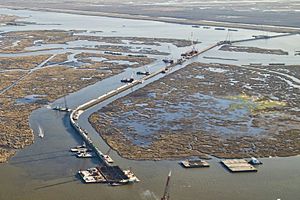IHNC Lake Borgne Surge Barrier facts for kids
Quick facts for kids Inner Harbor Navigation Canal Lake Borgne Surge Barrier |
|
|---|---|

|
|
| Coordinates | 30°0′20″N 89°54′5″W / 30.00556°N 89.90139°W |
| Crosses | GIWW, MRGO |
| Locale | New Orleans, Louisiana |
| Owner | US Army Corps of Engineers |
| Characteristics | |
| Material | Concrete, steel |
| Total length | 1.8 miles |
| History | |
| Construction begin | 2008 |
| Construction end | 2013 (major construction) |
| Construction cost | $1.1 billion |
The Inner Harbor Navigation Canal Lake Borgne Surge Barrier is a huge wall built to stop storm surges near New Orleans, Louisiana. It crosses two important waterways: the Gulf Intracoastal Waterway (GIWW) and the Mississippi River Gulf Outlet (MRGO).
This barrier runs from east of the Michoud Canal to south of the existing Bayou Bienvenue flood control structure. It has special gates that can close off the GIWW and Bayou Bienvenue. These gates help stop strong storm surges from Lake Borgne and the Gulf of Mexico from reaching the city. Another gate, called the Seabrook Floodgate, is located where the Inner Harbor Navigation Canal (IHNC) meets Lake Pontchartrain. This gate stops surges from Lake Pontchartrain from entering the IHNC.
Contents
Why Was the Barrier Built?
The Inner Harbor Navigation Canal (IHNC) surge barrier was approved by the United States Congress in 2006. Its main goal is to protect parts of New Orleans and nearby areas from storm damage. These areas include New Orleans East, the 9th Ward, and St. Bernard Parish. The barrier helps keep these places safe from powerful storm surges coming from the Gulf of Mexico and Lake Borgne.
How Was the Barrier Built?
This project received money from the American Recovery and Reinvestment Act of 2009. In April 2008, the US Army Corps of Engineers hired Shaw Environmental & Infrastructure to build the barrier. This was the largest project of its kind where the design and construction happened at the same time. This fast-paced method was needed to quickly reach a high level of flood protection by 2011.
In October 2008, the US Army Corps of Engineers approved the plans for the barrier. Construction of the main flood wall began on May 9, 2009. By October 21, 2009, all 1,271 main piles for the barrier were in place.
The barrier was used for the first time on August 29, 2012, to protect New Orleans from Hurricane Isaac. This date was also the seventh anniversary of Hurricane Katrina. By June 2013, most of the major construction work was finished.
What Is the Barrier Made Of?
The main part of the barrier is made of 1,271 concrete piles. Each pile is about 66 inches (1.7 meters) wide and 144 feet (44 meters) long, weighing 96 tons. Behind these concrete piles, steel piles are driven into the ground at an angle. These steel piles are 288 feet (88 meters) long and are installed in two parts. A concrete cap is placed on top to connect all the piles.
Two types of gates were built in the Gulf Intracoastal Waterway (GIWW) channel:
- One gate closes with two large steel "sector gate" leaves.
- The other gate is a "barge swing gate" that works like a giant door.
In the Bayou Bienvenue channel, a "vertical lift gate" was installed. This gate can be lifted up and down for smaller boats, like recreational crafts and shrimp boats.
Key Parts of the Barrier
Here are some of the main parts of the Inner Harbor Navigation Canal Lake Borgne Surge Barrier:
- A flood wall over a mile long that closes off the MRGO.
- A 150-foot wide (46-meter) navigable floodgate on the GIWW, which is a steel sector gate 42 feet (13 meters) tall.
- Another 150-foot wide (46-meter) navigable bypass floodgate on the GIWW, which is a concrete barge swing gate.
- A 56-foot wide (17-meter) navigable floodgate on Bayou Bienvenue, which is a steel lift gate.
- Concrete T-walls on land at both ends of the Lake Borgne barrier.
- Walls leading up to the GIWW sector gate and the Bayou Bienvenue gate.
- A navigation gate near Seabrook.
- New wetlands created by using organic material dug up during construction. This helps improve the environment.
Images for kids
More Information
- US Army Corps of Engineers New Orleans District Web Site
- Nola.com: Groundbreaking ceremony today
- Build It Bigger Season 4: Rebuilding the Levees


